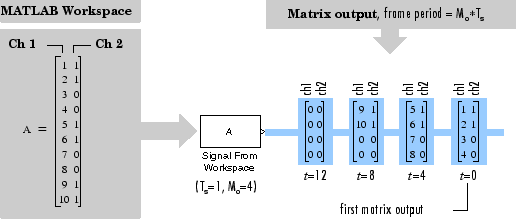Signal From Workspace
Import signal from MATLAB workspace
Libraries:
DSP System Toolbox /
Sources
Description
The Signal From Workspace block imports a signal from the MATLAB® workspace into the Simulink® model. The Signal parameter specifies the name of a MATLAB workspace variable containing the signal to import, or any valid MATLAB expression defining a matrix or 3-D array.
Unlike the Simulink From Workspace (Simulink) block, the Signal From Workspace block holds the output value constant between successive output frames (that is, no linear interpolation takes place). Also, the initial signal values are always produced immediately at t=0.
Examples
Ports
Output
Parameters
Block Characteristics
Data Types |
|
Direct Feedthrough |
|
Multidimensional Signals |
|
Variable-Size Signals |
|
Zero-Crossing Detection |
|
Extended Capabilities
Version History
Introduced before R2006a
See Also
Blocks
- Signal To Workspace | From Workspace (Simulink) | To Workspace (Simulink) | Triggered Signal From Workspace



